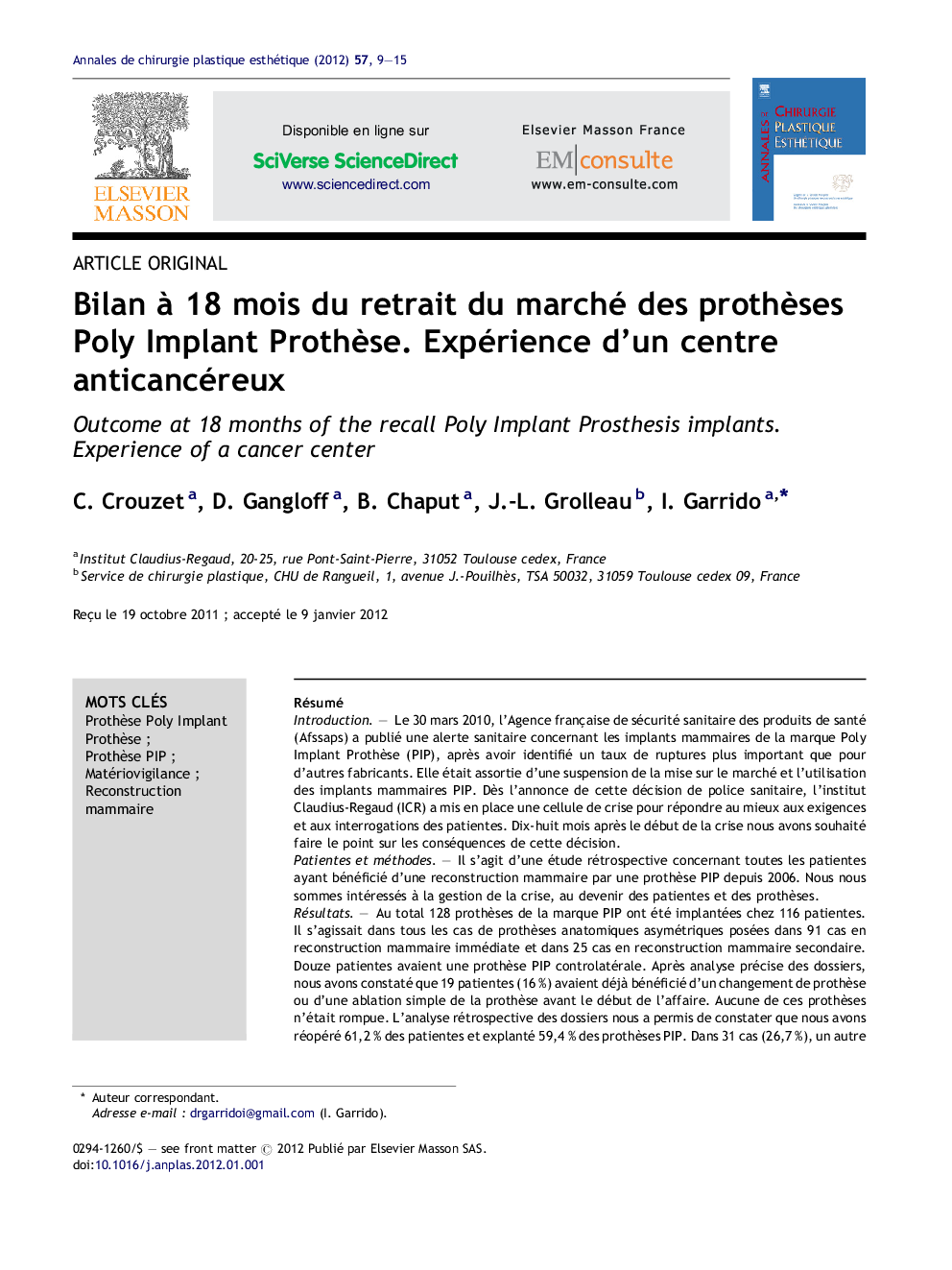| کد مقاله | کد نشریه | سال انتشار | مقاله انگلیسی | نسخه تمام متن |
|---|---|---|---|---|
| 3184803 | 1200804 | 2012 | 7 صفحه PDF | دانلود رایگان |

RésuméIntroductionLe 30 mars 2010, l’Agence française de sécurité sanitaire des produits de santé (Afssaps) a publié une alerte sanitaire concernant les implants mammaires de la marque Poly Implant Prothèse (PIP), après avoir identifié un taux de ruptures plus important que pour d’autres fabricants. Elle était assortie d’une suspension de la mise sur le marché et l’utilisation des implants mammaires PIP. Dès l’annonce de cette décision de police sanitaire, l’institut Claudius-Regaud (ICR) a mis en place une cellule de crise pour répondre au mieux aux exigences et aux interrogations des patientes. Dix-huit mois après le début de la crise nous avons souhaité faire le point sur les conséquences de cette décision.Patientes et méthodesIl s’agit d’une étude rétrospective concernant toutes les patientes ayant bénéficié d’une reconstruction mammaire par une prothèse PIP depuis 2006. Nous nous sommes intéressés à la gestion de la crise, au devenir des patientes et des prothèses.RésultatsAu total 128 prothèses de la marque PIP ont été implantées chez 116 patientes. Il s’agissait dans tous les cas de prothèses anatomiques asymétriques posées dans 91 cas en reconstruction mammaire immédiate et dans 25 cas en reconstruction mammaire secondaire. Douze patientes avaient une prothèse PIP controlatérale. Après analyse précise des dossiers, nous avons constaté que 19 patientes (16 %) avaient déjà bénéficié d’un changement de prothèse ou d’une ablation simple de la prothèse avant le début de l’affaire. Aucune de ces prothèses n’était rompue. L’analyse rétrospective des dossiers nous a permis de constater que nous avons réopéré 61,2 % des patientes et explanté 59,4 % des prothèses PIP. Dans 31 cas (26,7 %), un autre geste chirurgical avait été associé au changement de prothèse. Sur les 76 prothèses explantées, dix d’entre elles présentaient une anomalie (13,1 %). Trois prothèses (3,9 %) étaient rompues. Six prothèses (7,9 %) présentaient un phénomène de perspiration. La durée de vie moyenne de ces prothèses était de 21,3 mois. Parmi les patientes qui ont été réopérées, nous avons observé trois complications postopératoires (3,9 %).ConclusionPlus de 18 mois après le retrait de la mise sur le marché des implants mammaires PIP, nous avons revu la quasi-totalité des patientes implantées dans notre institution. À ce jour, plus de 60 % des patientes n’ont plus leur prothèse en place mais 16,4 % avaient déjà été opérées avant mars 2010. Plus de 10 % des prothèses avaient une anomalie dont trois présentaient une rupture franche. Cette étude rétrospective nous a aussi permis de constater que la prise en charge de nos patientes était perfectible, notamment sur la lisibilité du suivi et dans le domaine administratif.
SummaryIntroductionOn March 30, 2010, AFSSAPS (sanitary French) issued a medical alert about breast implants “Poly Implant Prothese” (PIP), because it was shown that its failure rate was higher than of other manufacturers. This alert was accompanied by a suspension of sales and use of breast implants PIP. Since the announcement of this decision, the Institut Claudius Regaud (ICR) has set up a crisis unit to best meet the demands and questions concerning patients who had PIP implants. After 18 months of the beginning of the crisis, we decided to review the consequences of this decision.Patients and methodsThis is a retrospective study of all patients who underwent breast reconstruction with a prosthesis PIP since 2006. We are interested in managing of the crisis, the fate of patients and the problems of implants.ResultsIn total 128 PIP prostheses were implanted on 116 patients. These were all cases of asymmetric anatomic implants placed in 91 cases in immediate breast reconstruction and of breast-delayed reconstruction in 25 cases. Twelve patients had a contralateral PIP prosthesis. After careful analysis of the records, we found that 18 patients (16%) had received a change of prosthesis or simple removal of the prosthesis before the beginning of the crisis. No prosthesis was broken. After the retrospective chart review we found that we reoperated 61,2% of patients and explanted 59,4% of prostheses PIP. In 31 cases (26,7%), another surgery was associated with the change of prosthesis. Of the 76 explanted prostheses, ten of them had an abnormality (13,1%). Three implants (3,9%) were ripted. Six implants (7,9%) had a phenomenon of perspiration. The average life span of these prostheses was of 21,3 months. Among patients who were reoperated, we observed three postoperative complications (3,9%).ConclusionMore than 18 months after the withdrawal on the market of breast implants PIP, we reviewed almost all patients implanted at our institution. To date, 60% of patients no longer have this prosthesis in place, but 16% of patients with this specific breast implant had already been remove before March 2010. Eighteen percent of implants had an abnormality and three had a rupture. In this retrospective study we also found that the care of our patients could be improved, including the legibility of the monitoring and in the administrative field.
Journal: Annales de Chirurgie Plastique Esthétique - Volume 57, Issue 1, February 2012, Pages 9–15